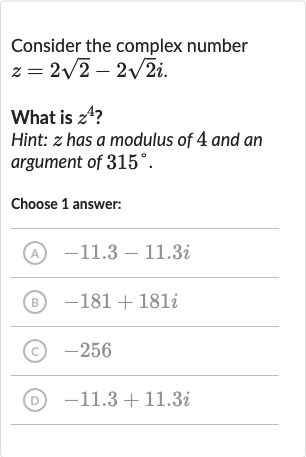Full solution
Q. Consider the complex number .What is ?Hint: has a modulus of and an argument of .Choose answer:(A) (B) (C) (D)
- Given complex number: We are given the complex number . We need to find .First, let's confirm the modulus and argument of .The modulus of is .The argument of is the angle in the standard position whose terminal side contains the point . This is a -degree angle in the fourth quadrant, which corresponds to degrees or radians.
- Confirming modulus and argument: Now, we can use De Moivre's Theorem to find . De Moivre's Theorem states that for a complex number in polar form , . Since we have the modulus and the argument degrees, we can apply the theorem to find .
- Using De Moivre's Theorem: Applying De Moivre's Theorem, we get: = = Since degrees is equivalent to degrees (full circle) times plus an additional degrees, we can simplify and to and .
- Applying De Moivre's Theorem: We know that and . Therefore,

